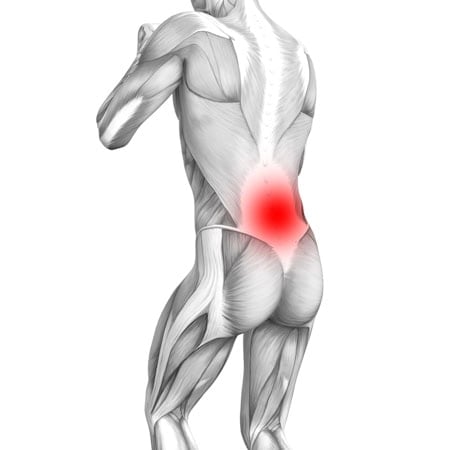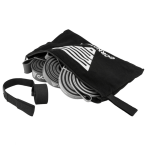Resistance Band Sumo Deadlifts
How to do Resistance Band Sumo Deadlifts?
Resistance band sumo deadlifts are a lower-body exercise that targets the glutes, hamstrings, and inner thighs, along with the core and lower back. By using a resistance band instead of a barbell, you can perform the sumo deadlift movement with the added benefit of variable resistance, where the tension increases as you stand up. This exercise is an effective, joint-friendly alternative to traditional weighted deadlifts, ideal for building lower body strength and stability with minimal equipment.
Steps to Perform a Proper Resistance Band Sumo Deadlift:
1. Set Up the Resistance Band Under Your Feet:
• Stand on each end of the resistance band, anchoring it securely with your feet placed wider than shoulder-width apart, with toes pointed slightly outward.
• Grab the middle of the band with both hands, keeping a neutral grip, and let the band rest between your legs. Ensure there is some initial tension in the band.
2. Set Your Posture and Engage Your Core:
• Bend your knees slightly and hinge at the hips, keeping your chest lifted and your back straight.
• Engage your core and keep your shoulders back, maintaining a neutral spine throughout the movement.
3. Lower into the Starting Position:
• Bend at the hips and knees to lower your torso, reaching down to grab the band with both hands. Your hips should be lower than in a conventional deadlift due to the sumo stance.
• Keep your arms fully extended, allowing the band to create tension as you get into position.
4. Drive Through Your Heels to Stand Up:
• Exhale as you press through your heels and extend your hips to pull the band upward, standing tall in a controlled motion.
• Squeeze your glutes at the top of the movement, fully extending your hips and knees without leaning backward.
5. Lower Back Down with Control:
• Inhale as you reverse the movement, bending at the hips and knees to lower the band back to the starting position.
• Keep tension in the band throughout, stopping just before it goes slack.
6. Repeat the Movement:
• Perform the desired number of repetitions, focusing on maintaining proper form and controlled movements.
Benefits of Resistance Band Sumo Deadlifts
• Builds Lower Body Strength: The exercise effectively targets the glutes, hamstrings, quads, and inner thighs, helping build strength and stability in the lower body.
• Improves Hip Mobility and Flexibility: The wide stance helps improve hip mobility, especially for those who may have tight hip flexors or adductors.
• Engages Core Stabilization: The banded deadlift requires core engagement to maintain posture and stability, helping to strengthen the core.
• Promotes Functional Movement Patterns: Sumo deadlifts mimic functional lifting motions, improving balance, coordination, and strength for everyday tasks.
• Joint-Friendly Resistance: The band provides smooth, progressive resistance that is gentle on the joints, making this exercise accessible for people with joint concerns.
• Portable and Convenient: With only a resistance band needed, this exercise can be done anywhere, making it ideal for home workouts or while traveling.
• Reduces Lower Back Strain: The sumo stance and use of a resistance band can help reduce strain on the lower back compared to conventional barbell deadlifts, making it a safer option for some.
Common Mistakes to Avoid
• Rounding the Lower Back: Avoid rounding your back by keeping your core tight, chest lifted, and spine neutral.
• Using Too Much Knee Bend: Remember that this is a hip hinge movement; focus on hinging at the hips rather than squatting down.
• Leaning Forward: Keep your torso upright and avoid leaning forward, which can shift weight off your heels and reduce engagement in the glutes and hamstrings.
• Using Momentum: Focus on slow, controlled movements rather than relying on momentum to lift the band.
• Letting the Band Go Slack: Maintain tension in the band throughout the movement by stopping just before fully lowering, ensuring constant muscle engagement.
Tips for the proper execution of Resistance Band Sumo Deadlifts
Engage the Core: Keep your core tight to stabilize your torso and protect your lower back throughout the movement.
Focus on Hip Hinge: Remember to hinge at the hips rather than relying on bending the knees too much; this ensures proper engagement of the glutes and hamstrings.
Keep Chest Lifted and Back Straight: Maintain a neutral spine by keeping your chest up and shoulders back, avoiding any rounding in the back.
Controlled Movements: Avoid using momentum; perform the exercise slowly and with control to maximize muscle activation.
Breathing: Exhale as you lift up and inhale as you lower down, helping maintain stability and rhythm.
Muscles worked when doing Resistance Band Sumo Deadlifts
Primary Muscles:
•Glutes: The gluteus maximus is heavily engaged during hip extension, especially at the top of the movement.
•Hamstrings: The hamstrings work to control the hip hinge and assist in extending the hips.
•Inner Thighs (Adductors): The wider stance of the sumo deadlift emphasizes the inner thigh muscles, helping to strengthen and stabilize the adductors.
Secondary Muscles:
•Quadriceps: Assist in stabilizing the knees and support hip extension, especially at the bottom of the movement.
•Core: Engages to stabilize the torso and protect the spine throughout the lift.
•Lower Back: The erector spinae muscles support spinal alignment and help maintain proper posture.
•Forearms and Grip: Help maintain a firm hold on the band as you lift, improving grip strength.
Primary Muscle(s):
Secondary Muscle(s):

Lower back
Adjust the difficulty of Resistance Band Sumo Deadlifts
How to make Resistance Band Sumo Deadlifts harder?
How to make Resistance Band Sumo Deadlifts easier?
How to make Resistance Band Sumo Deadlifts harder?
To make Resistance Band Sumo Deadlifts harder:
-
Use a Heavier Resistance Band: Increase the challenge by using a band with more resistance, further engaging your glutes, hamstrings, and core.
-
Widen Your Stance: Widening your stance can increase tension on the inner thighs and make the exercise more challenging.
-
Add a Hold at the Top: Pause at the top for 2-3 seconds, squeezing your glutes to increase time under tension and maximize muscle engagement.
-
Slow Down the Eccentric Phase: Take extra time lowering back to the starting position, focusing on controlling the movement to engage the muscles more deeply.
How to make Resistance Band Sumo Deadlifts easier?
To make Resistance Band Sumo Deadlifts easier:
-
Use a Lighter Resistance Band: Choose a band with less resistance, making it easier to maintain control and proper form.
-
Limit Range of Motion: Lower only partway instead of reaching all the way down, reducing the intensity and allowing you to build strength gradually.
-
Perform Fewer Repetitions: Start with fewer repetitions (e.g., 8-10) and increase as you become more comfortable with the movement.






